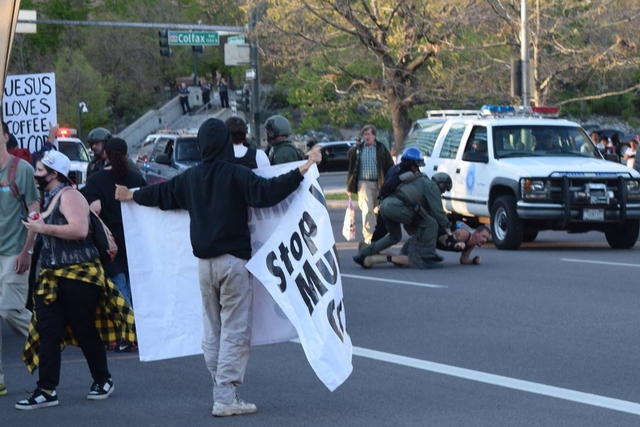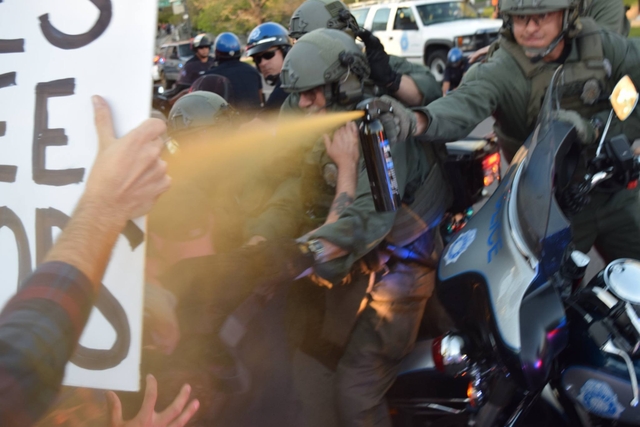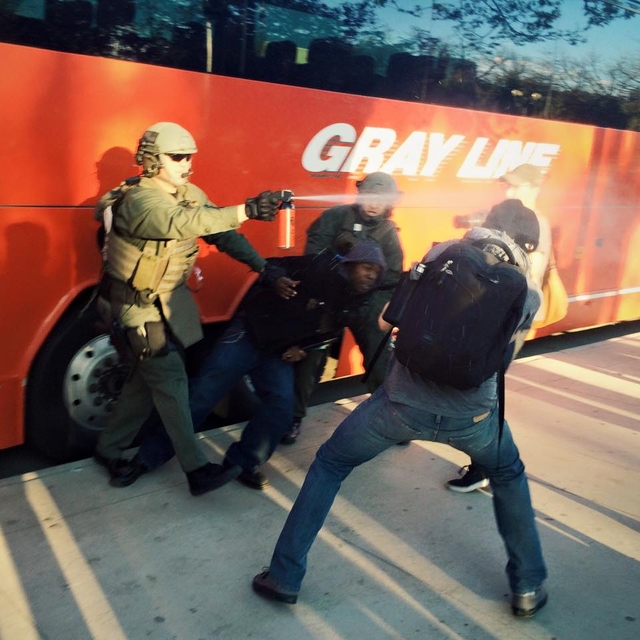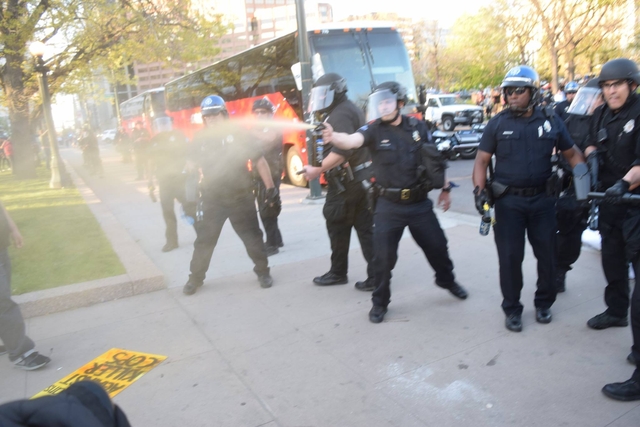Report Back: Denver March in Support of the Baltimore Uprising (4/29)
On the afternoon of May 1st I attended the annual May Day demonstration in Denver. I think it was a larger turnout than last year. But after about a minute I remembered how much I hate things like being in a group of people I don’t (but should) know, standing around “protesting” with signs and slogans, and generally being in a city. So I right away walked back to Union Station and got the next bus home.
As I walked away from the demonstrators the only police I noticed were some officers staged around the corner of the capitol building largely out of sight so as not to incite any conflict. This was in contrast to the method employed by the Denver Police Department (DPD) across the street from the capitol during a protest demonstration I attended only a few days earlier. That protest, on the Wednesday prior to May Day, was a march organized by the Denver Community Defense Committee (and others) in support of the rioters in Baltimore and of the protest movement sparked by the murdered students of Ayotzinapa.
My sister met me downtown and attended the march with me, so it was way more fun than when I try to do protesting by myself. We gathered in front of the detention center and courthouse (where I was once detained, and where I was tried and convicted for my role in the Occupy Denver camp almost exactly three years ago). Many cars honked in support as they drove by. Some organizers with permanent markers moved through the crowd making sure everyone who wanted it had the jail support phone number written on their bodies. A member of the ISO was handing out free copies of the latest Socialist Worker. Free copies. When the Trotskyists are giving away their newspapers you know Full Communism can’t be far off.
Once around 100 people had gathered, we moved into eastbound Colfax Ave leaving only one lane open for traffic. Even then we got honks of support from motorists. The police materialized from behind the protesters, moving west up the eastbound side. We turned to face them. I got pressed into service holding one of the banners at the front of the group (via a classic “would you hold this for a second?” move by its previous handler). A line of police on motorcycles drove up to the protest, stopping suddenly only inches from those of us in front so as to prevent us from marching forward down the street. After a brief standoff we moved to the sidewalk and walked past the line of motorcycles.
For the next couple of blocks the police carelessly and intentionally swooped their heavy motorcycles close to marching protesters in an attempt to keep them on the sidewalk. Many other police vehicles carrying officers in crowd-control gear including a DPD SWAT team riding on an SUV had also responded to the gathering. We lost our motorcycle escort briefly at Civic Center Park where Colfax bends away from the sidewalk, so when we turned right onto Broadway we were in the shoulder of the street again.
The motorcycles quickly caught up and resumed trying to herd us off of the street. One sped right up beside me, almost right into me, and shouted to MOVE TO THE SIDEWALK! I was looking forward at that moment and was startled by his maneuver and the only thing I could think to say in response was, “be careful.” He repeated, this time in a quieter tone, his command for me to move to the sidewalk. I replied, “ok, but while we are in the street, be careful with your bike.” At that point we were approaching two big tour buses parked on the shoulder of Broadway; he drove off up ahead to find someone else to yell at while I decided to go around the buses on the sidewalk in order to avoid being squeezed between them and the police. I also took the opportunity to abandon my job as a banner holder. I think the other guy was better off without me anyway.
Just as I passed the second bus, the police attacked. I heard a scuffle in the street on the other side of the buses. I jogged back to see several police arresting a protester wearing a backpack. Luckily, as the police were walking him away he managed to toss his backpack in the street where another protester grabbed it before any of the cops could.
While I was watching, one of the green-clad tactical guys armed with one of those large riot revolvers that shoot 40mm cannisters shoved the guy next to me and then pointed his weapon at my chest and told me to get back. I didn’t know if he was loaded with impact rounds or tear gas, but at that range I assumed anything would be ‘more or less lethal’, so I backed up then returned to the sidewalk.
That’s when I realized it was not an isolated arrest. Several people between and beside the buses had been pepper sprayed, some tackled on the pavement, and were being bound while other police in crowd-control gear were pepper spraying onlookers. My sister and I both got only a very light misting which caused a bit of coughing and brief eye burning… but I saw several people take multiple full sprays directly to the face.
The group spent quite a bit of time in Civic Center Park recovering and flushing eyes with water and milk. The police made a few excursions into the park to grab and arrest a few more protesters. I don’t know why some people were targeted, but I’m assuming they were grabbing people they could identify as having been in the street earlier so they could charge them with minor traffic offenses and remove them from the protest (there were forensics officers video recording the entire march).
Once everyone had more-or-less recovered we continued our march to the 16th Street Mall and around downtown Denver before people began dispersing. After the attack on Broadway, my priority for the rest of the march was to make sure neither myself nor my sister got arrested. That meant leaving the group at one point as it headed down an alley-less street toward police where I feared a kettle and possible mass arrest. Fortunately the group was able to turn, and we caught back up to them on the mall a little before everyone dispersed.
In total 11 people were arrested. Most were charged with misdemeanors, but there were also at least two felony assault on police charges. Two protesters that I know of were hospitalized while in custody for the injuries they sustained during their arrests.
Videos
There are several videos of the march available online, especially of the police attacking protesters on Broadway, including some footage posted to Vimeo by Unicorn Riot. The videographer during much of that footage is next to me, so it actually provides something near to my point-of-view during the first bit of the protest.
David Long captured video of several of the arrests which I did not witness myself:
Finally, the DAM Collective posted several videos to YouTube, including this one which shows the general mood of both protesters and police before and during the attack:
Why Did They Attack?
The attack on Broadway surprised me, and the apparently unprovoked aggression struck me as unusual even by DPD standards. I am not the most experienced street protester (refer to the list of things I hate in the first paragraph), but most unpermitted marches I’ve seen are controlled by police by blocking intersections in order to force the group to halt or turn until everyone gets tired and goes home (or, if the police had time to prepare, until most protesters are kettled and arrested).
But this attack occurred in the middle of a block, after we had been walking for only a few minutes, and when a good portion of the protesters were on the sidewalk. There was a rumor that the attack was precipitated by a protester jumping onto or knocking over a police motorcycle. And after the march the Denver Post reported, quoting a police spokesperson, that the trigger for the attack was when “An officer got knocked of[f] his motorcycle as he was basically patrolling.”
However, on May 1st Jesse Benn posted a clear video to YouTube showing the incident which incited the attack by police. In the video, a police officer on a motorcycle is seen riding very close to a bicyclist who was riding along with protesters. The cyclist can be seen defensively sticking his elbow out as he is crowded by the motorcycle, at which point the officer, who is trying to balance at a very slow speed, manages to drop his bike. In response that officer and the tactical team are seen to immediately rush the protesters.
(May 14: the video is no longer public at this time. I’m guessing it was made private at the request of the legal defense of the protesters involved. I am hoping Benn will make the video public again once all criminal cases have been dropped or completed.)
Benn was arrested after recording the incident in the video above. His wife, who was also documenting the action with her phone, was forced up against a bus with a police baton to her throat. Her phone was confiscated and is apparently lost — presumably destroyed by the DPD. The couple was interviewed as part of a CBS4 report a few days after the protest which is available online as “Pregnant Woman’s Phone Taken During Police Protest That Ends In Arrests” (May 4, 2015).
On May 22nd, Michael Moore, the bicyclist in question, posted to his Facebook page that all three charges filed against him had been dismissed (assault on a peace officer, criminal mischief, and resisting arrest). According to a report at NotMyTribe.com, Moore spent two days in jail after his arrest.
So the aggression on the part of DPD seems to have been largely unprovoked. Perhaps the situation in Baltimore and the fact that there was another Denver-Baltimore solidarity demonstration the night before contributed to tensions which had the police officers on edge. It may be worth noting that Civic Center Park was also the scene of Denver’s October 2011 Mini-Uprising, which itself involved an officer being pushed off of his motorcycle by a protester.
But whatever the reason for their actions at this particular demonstration, the fact that police so often confront political protests at all is a curious phenomenon. Surely everyone involved — protesters, police officers, police commanders, municipal administrators — knows that police presence and police aggression merely extend the duration of demonstrations, cause injuries, and amplify (many times over) the impact on traffic and business.
During Wednesday’s march the DPD was able to use one officer’s embarrassing motorcycle slip as an excuse, but police will sometimes go to great lengths including undercover provocateurs to stir up trouble and elicit violent confrontations with protesters. While individual police officers may benefit from [overtime] pay, everybody else (including the municipal treasury, especially after any resulting civil suits are paid) may incur very steep costs. So what’s the reason such expensive crowd-control methods have evolved and persist?
In Chapter 8 of his book, Our Enemies in Blue, Kristian Williams provides a description of the various crowd control methods favored through the history of modern policing. During the middle of the 20th century, into the 1970s, police adhered to a strategy of “Escalated Force” (as opposed to previous strategies of “Maximum Force”), the implementation of which Williams describes in the following passage:
Dispersal operations are not designed to uphold the law or to protect public safety; often the police action itself will represent the most serious violation of the law and constitute the greatest threat to the safety of the community. Instead of the law or public safety, the police are concerned with establishing control, maintaining power. (p. 184)
Williams goes on to note that after the failure of police to control the 1999 Seattle protests there has been a return to the haphazard (but also increasingly disciplined/militarized) use of force to control protests:
Riot gear, tear gas, mass arrests, and widespread violence have again become common features of demonstrations. While police violence has always been a possibility, it has lately come to resemble an open threat. Some of this is surely deliberate. The threat of violence is an effective tool for suppressing the attendance at a gathering, especially among portions of the population who are more routinely subject to police attack. It also serves to criminalize dissent. When members of the public see the police in riot gear, it is easy to assume that the crowd they are monitoring is dangerous, or even criminal. But some of the police reliance on force is the product of desperation. They simply don’t know what to do, and while they figure it out, the old-fashioned, straightforward head-knocking approach seems like a safe bet. (p. 193)
And indeed things make more sense if police (especially riot police) are thought of as producers of fear and discipline rather than as producers of peace. For at least a brief time during a political protest, the protesters themselves perform the difficult police task of intelligence gathering by making themselves visible as dissenters on the streets. This provides a good opportunity for police to dissuade further dissent by putting on an intimidating display of paramilitary force as a sort of counter-protest, recording the faces of those present as a convenient means of surveillance, as well as visiting physical pain and the promise of future punishment at the hands of the criminal justice system upon a sample of protesters.
Attacking protesters also provides police with an opportunity to target known activists and organizers in attempts to disrupt the activities of already-known subversive groups. For example, one of the arrested protesters on Wednesday was Dave Strano, a well-known anarchist organizer in Denver. Strano was charged with several misdemeanors including interference and resisting arrest. As described in a weblog post by the Denver Anarchist Black Cross,
Dave was assaulted and received injuries by the police, including a gash to his head, a broken clavicle and a twisted knee. He was take to the hospital where he was left shackled to the bed covered in pepper spray, and they refused to provide him with crutches after 8 hours. His friends were able to to bring crutches to the jail so that he could walk when he was finally released.
Strano was bonded out the day after the solidarity march, but soon after he was released the district attorney’s office decided to charge him with an additional felony. Denver police then waited until he was driving with his children before pulling him over and arresting him a second time for the same protest, all apparently in an attempt to intimidate Strano and his family.
Of course, even powerful police forces are not completely autonomous. They must avoid too much public and political scrutiny if they wish to continue existing in their current forms — and existing is what police forces do best. Police, then, must balance meting out discipline at political protests with avoiding too many expenses and too much scrutiny-inducing controversy.
So the police response to any given political protest is difficult to predict. Some times, such as during May Day this year, they will remain discreet in order to keep things calm. Other times they will start hitting and pepper spraying after a demonstration has marched only a few blocks.
For the same reasons, police always urgently couch their violence in the rhetoric of ensuring “health and safety” — their survival depends on the public believing (or at least having the option to believe) they perform such a beneficial function rather than being seen as merely class enforcers. As an example during our Baltimore solidarity march in April, after the police responded in force and, unprovoked, went out of their way to inflict pain on whichever protesters they could get their hands on with pepper spray, beatings, and arrests, their PR department tweeted that “Anti-Police Protestors [sic] are now marching on the 16th St Mall. Denver Police are protecting them and ensuring public safety.”
UPDATE: Anti-Police Protestors are now marching on the 16th St Mall. Denver Police are protecting them and ensuring public safety.
— Denver Police Dept. (@DenverPolice) April 30, 2015The way police describe themselves as those who “protect and serve” while providing “health and safety” is part of the same language of counterinsurgency which has become standardized over the past 50 years or so of uprisings — most recently in Ferguson and Baltimore — which seeks to valorize both the police and “peaceful protesters” while blaming the impoverished “thugs” who stand up to state violence for their own condition and discrediting those who sympathize with the oppressed as “outside agitators” and “white anarchists”.





